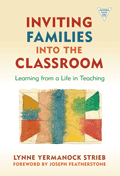The Harvard Family Research Project separated from the Harvard Graduate School of Education to become the Global Family Research Project as of January 1, 2017. It is no longer affiliated with Harvard University.

|
April 14, 2011 Book Review: Inviting Families into the Classroom: Learning from a Life in TeachingAshley Chu
|
Book Review
Ashley Chu is a graduate research assistant at Harvard Family Research Project and is currently studying education policy in the masters program at the Harvard Graduate School of Education.
Inviting Families into the Classroom: Learning from a Life in Teaching,1 by Lynne Yermanock Strieb, provides readers with insights on family engagement from the perspective of someone with 31 years of experience teaching kindergarten, first grade, and second grade in Philadelphia public schools. Drawing on a rich archive of journal entries, notes to and from parents, and her newsletters for families, Strieb discusses challenges faced, mistakes made, and lessons learned during the process of learning how to effectively communicate with families. While Inviting Families into the Classroom discusses parent–teacher relationships more broadly, this review focuses on the book’s value for building relationships with families whose children are transitioning into elementary school.
BUILDING RELATIONSHIPS DURING EARLY TRANSITIONS
Smooth transitions into kindergarten and the early elementary grades are vital to preparing young children for school success, and reaching out to families during these transitions is key to setting a strong foundation. Practitioners seeking to build relationships with families during the early school years will find Strieb’s book informative, as it offers insight into the “how” piece of family engagement: Strieb goes beyond why teachers should communicate with parents to the intricacies of how to facilitate this communication. However, Strieb is not prescriptive—she shares how her beliefs, values, experiences, and assumptions led to her own family involvement practices, allowing readers space to develop their practices while considering their own contexts.
PRACTICES TO ENGAGE FAMILIES
Because the school setting can be a daunting place for families new to the school system, teachers play a critical role in facilitating transitions by inviting families to communicate and share their interests and concerns. Strieb describes her use of a regular newsletter she sent home with her students as a way to bridge the communication gap with families. The newsletter included information about the curriculum, examples of how parents could help their children at home and at school, and an open invitation for parents to communicate with the teacher. Prompted by the newsletter and other informal invitations, parents then shared information—ranging from details about children’s home lives to parents’ concerns over school policy—that a teacher otherwise could not have known.
Homework was another tool Strieb used to engage parents. She grappled with many concerns around assigning homework, including finding the appropriate balance between students’ independent work and adult help, and creating homework that enabled parents who could not read English to support their child. She found that in general, families enjoyed homework that involved talking with adults. For example, for one homework assignment, students asked their parents about the story behind the students’ own names, and then shared that story with the class. Eventually the assignment led to a class book in which each student had his or her own page with the story that emerged from discussions with their families. Through such homework assignments, fluidity between home and school is established. When parents are encouraged to be active in children’s homework in simple ways during the early elementary years, it can set the stage for continued interest and involvement in their children’s education.
Viewing family participation in the school as a valuable learning opportunity for the teacher, parents, and students, Strieb also made a consistent effort to bring families into her classroom. Such involvement both helps parents to understand the teacher’s role and teaching strategies, and offers a chance for parents to share their talents, skills, and cultures with the class. Through parent meetings and get-togethers, Strieb modeled ways that parents could participate in the classroom, and by inviting parents, she offered specific ways in which they could contribute. For example, parents who had recently had a baby were invited to come in a few times over the course of the year with the baby so that students could observe the child’s growth and make connections with lessons in science, social studies, and health. Parents were also invited to give presentations or demonstrations related to their work and interests, thus providing new perspectives to the curriculum and connecting children with the outside world.
CONCLUSION
Throughout the book, Strieb candidly reflects on her years in the classroom, acknowledging both the value of engaging families and the inevitable challenges and tensions that arise in doing so. She highlights both successes and failures, pointing out lessons learned and things she would have done differently. Inviting Families into the Classroom offers a valuable perspective from decades of thoughtful practice. Strieb recognizes that engaging families is not always easy work, but it is important work because it builds relationships that are foundational in fostering students’ school success.
1. Strieb, L. Y. (2010) Inviting Families into the Classroom: Learning from a Life in Teaching. New York: Teachers College Press.
